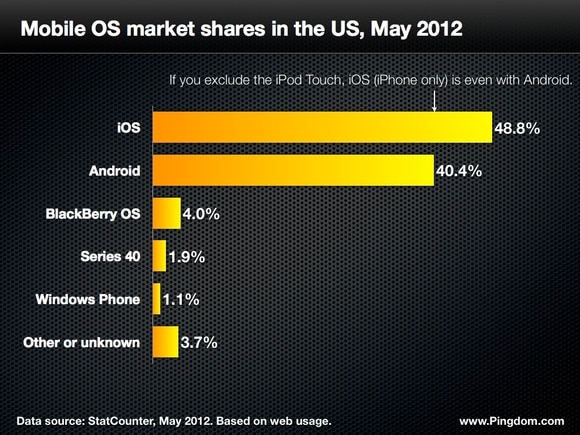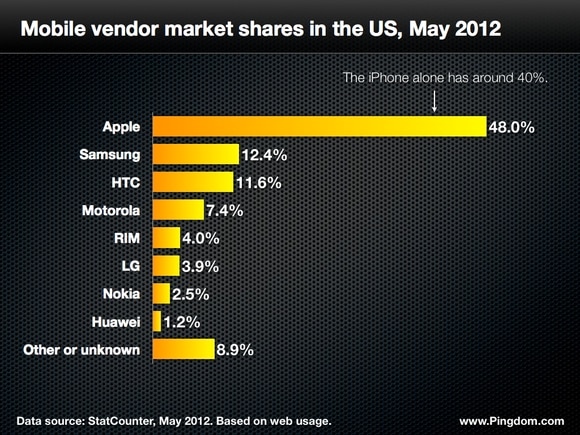 The United States may be overtaken by China as the world’s largest smartphone market this year, but it’s nevertheless a huge and highly influential market. According to Comscore, more than 100 million Americans now own a smartphone, a number that keeps growing.
The United States may be overtaken by China as the world’s largest smartphone market this year, but it’s nevertheless a huge and highly influential market. According to Comscore, more than 100 million Americans now own a smartphone, a number that keeps growing.
We thought it would be interesting to take a closer look at the state of the US smartphone market. Where is it, and what are the trends? As you’ll see, things have changed dramatically in very little time.
One of many signs that smartphone adoption is exploding is that as of May this year, 9.1% of all web usage in the United States happened via mobile devices. Two years ago, that number was just 3.3%.
Note that we have based this report on web usage from small-screen mobile devices. The statistics we used (from StatCounter) are dominated by smartphones, but there are also some other devices, such as the iPod Touch, the Nintendo 3DS, Sony PSP, and other web-enabled small-screen devices. So, strictly speaking, this article should maybe have been called, “State of the US mobile device market.”
Note: These statistics do not include tablets (such as the iPad, etc).
Mobile OS usage in the US
The iOS number in the chart above includes both the iPhone and iPod Touch. Based on mobile browser usage, 82% of those iOS devices are iPhones. The remaining 12% are iPod Touches. (Note once again that iPads are not included here.)
If you choose to exclude the iPod Touch from these stats (say, to estimate smartphone market share), iOS and Android are pretty much neck and neck. The trend, however, is that the iPhone is gaining users faster than Android. At least that has been the pattern this past winter.
Worth observing is that iPod Touch alone generates twice as much web usage as RiM’s BlackBerry.
Mobile vendors, Apple in a league of its own
No single vendor is anywhere near Apple in the United States. Even without counting the iPod Touch, Apple would have around 40% of the market.
Samsung, which according to some sources is now the major smartphone vendor in the world, is far behind Apple in the US. It’s the biggest Android vendor, though, followed by other vendors such as HTC and the now Google-owned Motorola.
Notable trends
- The dramatic fall of BlackBerry. RiM has gone from having north of 30% of the smartphone market two years ago, to 23% a year ago, to 4% today. That’s a pretty extreme change in such a short time. Many of its users have clearly migrated to Android and the iPhone. In the United States, BlackBerry is a platform in free fall.
- Android has reached a plateau. Two years ago, Android had less than 15% of the market. A year ago, 32%. Today, 40%. However, in terms of market share, Android now seems to have reached a plateau. It’s been hovering around the same market share for about half a year now.
- iOS is growing faster than Android. A year ago, iOS had 34%, today almost 49%, compared to Android’s 40%. The popularity of the iPhone 4S has clearly had an impact here. That the iPhone is now also available on Verizon and Sprint, not just AT&T, is also sure to have helped. iOS has been pulling away from Android since last fall. Interestingly, these numbers are somewhat at odds with recent reports from Comscore, which claim that Android has a significant lead over Apple in terms of smartphone subscribers. It might be that a large share of Android users do not use their smartphones to access the Web, which would explain the discrepancy.
- Windows Phone is gaining, but slowly. As of May this year, it had 1.1% of the market. That’s up from 0.5% a year ago, pretty slow adoption in terms of absolute numbers. On the other hand, in terms of relative growth it’s up 100% in one year.
Final words
Note, once again, that all market share numbers in this article are based on web usage. They will therefore not exactly reflect the number of devices in use out there.
Apple’s grip on the US mobile market is strengthening. The company has a fight on its hands with the collective might of the Android vendors against it, but if the iPhone 5 becomes as successful as the iPhone 4S has been, it’s quite possible that iOS will gain even more market share over the coming year.
Image credit: Top image via Shutterstock.
Further reading: For those interested, we recently wrote an article about how mobile web usage differs across the world.


























